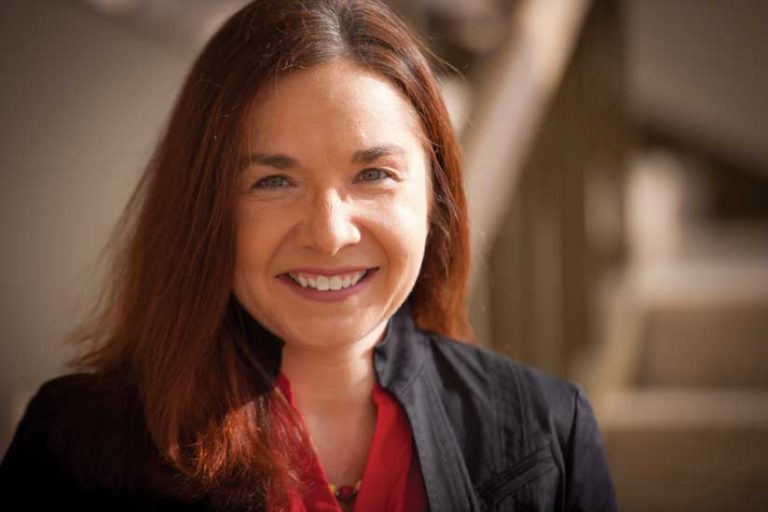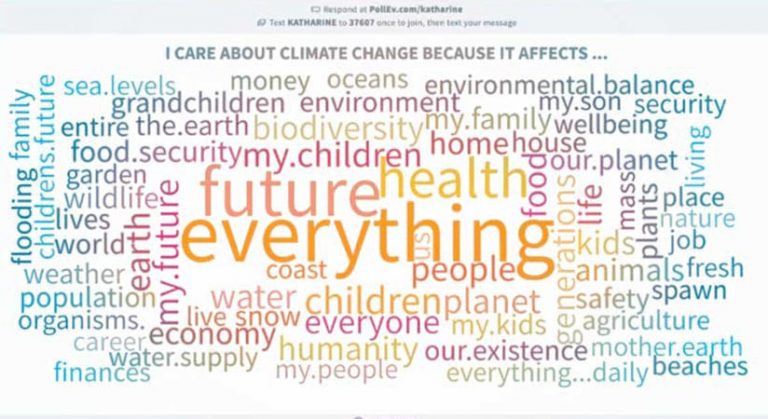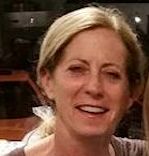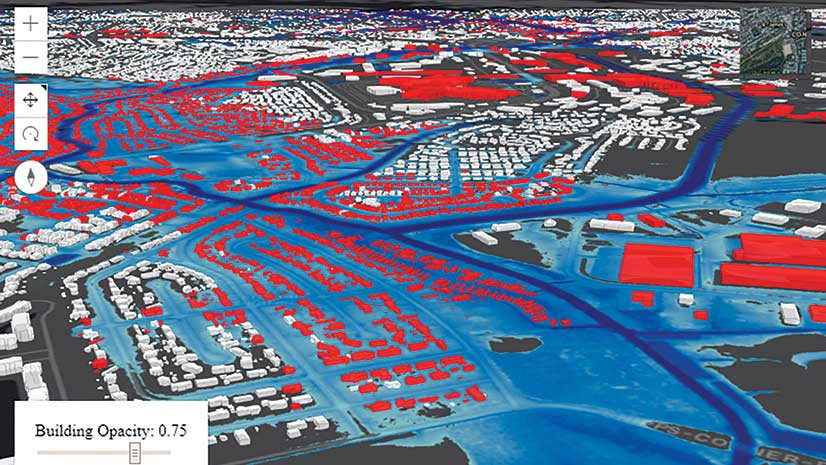Although addressing the online audience remotely from Lubbock, Texas, Katharine Hayhoe, the 2020 Esri Science Symposium keynote speaker, was anything but remote. In her dynamic and interactive presentation, “The First Step to Tackling Climate Change,” Hayhoe took on the seemingly intractable problem of building consensus and taking meaningful action to lessen human impacts on the environment and curb climate change.
Her presentation was part of the fifth annual—and first virtual—Science Symposium, held on July 16, 2020. The coronavirus disease 2019 (COVID-19) pandemic caused the symposium to rapidly morph into an online event. In previous years, the symposium not only highlighted scientific work enabled by GIS technology but provided an opportunity for the scientific subset of the Esri user community to network.
While face-to-face interactions were sacrificed this year for safety’s sake, the event became more broadly accessible. The nearly 1,200 (virtual) attendees this year was more than doubled attendance the previous year. The event attests to Esri’s commitment to supporting the science done by its users and staff and the science that underpins its products. Esri staff are actively involved in research and in organizations that support science as well as publishing books on the scientific applications of GIS, such as the recently released GIS for Science, Volume 2.

Examining What Is Needed
Dubbed “the Climate Explainer” by the New York Times, Hayhoe is an atmospheric scientist who is a professor in the Department of Political Science, and a director of the Climate Center at Texas Tech University. She is also a United Nations Champion of the Earth. She holds a bachelor’s degree in physics and astronomy from the University of Toronto and a master’s degree and a doctorate in atmospheric science from the University of Illinois, Urbana-Champaign. A prolific author of more than 125 peer-reviewed papers, abstracts, and other publications, she is also a frequent speaker on climate change and its impacts, effective communication, and faith.
In a compelling hour-long presentation, Hayhoe used insights gleaned from cognitive neuroscience and maps showing the distribution of public opinion on climate change in the United States to explore the approaches that have been used and why they haven’t worked. The event drew a diverse audience that came from industry, academia, nonprofits, consulting, and other sectors. She immediately included the online audience with interactive polls that captured their reactions and displayed them in maps, charts, and word clouds.

Hayhoe noted that when people are asked to take action on climate change, they most often think of what they can do as individuals. These actions can include installing smart thermostats, using LED lightbulbs, and practicing recycling. While she acknowledged that these are all positive things, they fall far short of what is necessary.
For example, the use of LED lightbulbs has cut CO2 by 570 million tons each year. This sounds impressive until it is placed in context. Since the annual CO2 output is 33,000 million tons, using LED lightbulbs accounts for only slightly more than 1.7 percent of emissions. “We need more,” she said.
Given the scope of the problem, the more required for affecting a solution is policy change. However, the current and projected states of global temperature increase, as visualized by the Climate Action Tracker, show that the goal of limiting temperature increases to no more than 2 degrees Celsius—as stipulated by the 2015 Paris Agreement of the United Nations Framework Convention on Climate Change (UNFCCC)—will not be met by the majority of signatories to the pact.
When More Isn’t Better
The nearly universal reaction to this lack of action is to conclude that people don’t understand enough science. The response to this perceived lack is to pummel climate change naysayers with studies and data that show the dire trajectory for the planet in the belief that explaining the facts is enough to change minds.
However, scientific evidence of climate change has been well-known since the 1820s and is well documented. A simple search on climate change in Google Scholar reveals more than 2.6 million studies. Numerous national climate assessments—running into the thousands of pages—have been published. As Hayhoe noted, “We have plenty of science demonstrating the reality of climate change driven by human actions.”
The objection she most commonly hears from climate change skeptics is that “it’s been warmer before.” She uses paleoclimate data to counter that argument and points out that, while temperatures have been higher, they have never been this high in human history.
The disastrous effect of climate change is brought home to people every day in news headlines that describe epic wildfires, instances of sea level rise, and extreme weather events.
What Will It Take?
The science is available and compelling, the consequences can be observed first-hand, and the stakes couldn’t be higher. If individual action isn’t the answer and a deluge of doomsday scientific data won’t motivate policy change, what will it take to make people act and—act rapidly?
To answer this crucial question, Hayhoe produced a visualization by the New York Times of Pew Research Center data collected in 2020 on the issues on which Republicans and Democrats are most divided. It was presented in descending order, and climate change tops the list as the most politically polarized topic in the United States. But this situation is also true in other countries.
Using a series of thematic maps produced by the Yale Program on Climate Change Communication, Hayhoe explored this phenomenon further. These maps show by county and congressional district that for most questions related to climate change, party affiliation is the single most decisive factor influencing the type of response.
However, the maps also showed something else. While most people of either political affiliation acknowledged the reality of climate change, they don’t think it will affect them, they think they can’t do anything about it anyway, and they never talk about it.
Hayhoe posits that the answer to this perplexing situation is not found in climate science but in the science of the human mind. She pointed to the work of Tali Sharot, a professor of cognitive neuroscience in the department of Experimental Psychology at University College London. Sharot’s research shows that the brain is programmed to get a kick out of new information, but it will only accept that information if it harmonizes with existing beliefs, a phenomenon popularly known as confirmation bias. [Learn more by watching Sharot’s TED Talk.]
Like most animals, people actively pursue rewarding activities but withdraw from situations that cause fear and anxiety and become inactive. Continuing to shovel an ever-increasing number of scary facts about the consequences of climate change will not only fail to change minds but will harden preconceptions. In short, the effort to scare people into action appears futile despite the fact that emphasizing global doom has overwhelmingly been the most widely employed strategy.
When Hayhoe asked attendees to name what they thought was the most convincing scientific fact that would spur climate action, increases in extreme weather conditions topped the list, followed by the melting ice in the Arctic and rising sea levels. Although these facts all make a strong case for concern about climate change, they are often perceived as distant in time and space and therefore not compelling.
Talk That Inspires Hope and Action
How can this vicious cycle be broken? Hayhoe’s answer: talk about climate change but in a way that engages people, helps them appreciate the immediacy of the problem, and encourages positive action.
Instead of using images of polar bears trapped on shrinking ice floes, make people realize that climate change is something that will harm them personally. She urged using examples of the increasingly common local flooding and fires events that necessitate changing zoning laws and enhancing public safety response.
Hayhoe also recommended localizing and scaling data that is readily available from the ArcGIS Living Atlas of the World to quantify these impacts in terms of people and dollars. This same approach can be used to show where improvements have been made—such as the increase in the use of renewable energy sources—to demonstrate beneficial practices that are gaining traction.
Instead of using data to bludgeon people who are dismissive of climate change, Hayhoe advocates employing insightful methods of connecting with people by talking about how and why addressing climate change is important to them—right now—and inspiring them to action by sharing what can be done to improve the situation. This will create a positive feedback loop that will lead to action.





